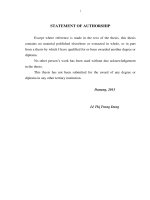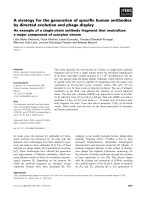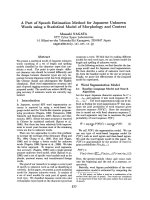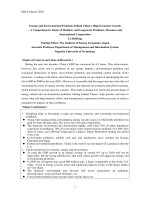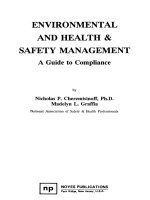TANNING: A MAJOR SOURCE OF ENVIRONMENTAL AND HEALTH HAZARDS
Bạn đang xem bản rút gọn của tài liệu. Xem và tải ngay bản đầy đủ của tài liệu tại đây (305.12 KB, 17 trang )
<span class="text_page_counter">Trang 1</span><div class="page_container" data-page="1">
4.3 Chromium in the Environment <small>4.3.1Chemistry of Chromium Salts</small>
<small>4.3.2Chromium in the Water, Soil and Atmospheric System</small> 4.4 Occupational Hazards
4.5 Effects on Health and Environment
<small>4.5.1Effects of the Constituents Used in Leather Processing on Human Health4.5.2Effects of Chromium on the Aquatic Ecosystems</small>
<small>4.5.3Effects of Chromium on the Terrestrial Ecosystems4.5.4Effects of Chromium on Human Health</small>
4.6 Management of Waste and Hazards (Treatment, Handling and Disposal) 4.7 Let Us Sum Up
4.8 Key Words
4.9 References and Suggested Further Readings 4.10 Answers to Check Your Progress
The tanning industry or the leather industry is one of the most polluting industries and it has been designated as a hazardous industry under the Factory Act, 1948. It is a major source of pollution that causes significant environmentaland human health impacts (Ros and Ganter, 1998). The raw material used in this industry is a byproduct of the meat industry. Leather which is a product of these industries is used for the manufacture of handbags, bags, purses, belts, jackets, cases for mobile phones, laptop cases, shoes, seats for vehicles and a number of other products. Leather is expensive and leather products are important earners of foreign exchange. Bovine hide is the most important raw material for the leather industry. The wastes from this industry have organic and inorganic constituents, high oxygen demand and toxic chemical constituents that can impact the environment (Song et al. 2000). In particular, chromium and chlorinated phenols are important constituents of this industrial waste (Mwinyihija et al. 2006). Chromium is a heavy metal and is an inorganic transition metal pollutant which exists in several oxidation states. For example, the trivalent Cr<small>3+</small>and hexavalent Cr<small>6+</small>species are the most common forms of chromium found in the environment (Kotaœ and Stasicka, 2000). The tanneries emit toxic odour. Some other chemical pollutants of concern from the tanning industry include: azodyes, antimony, arsenic, barium, cadmium compounds, cobalt, copper, formaldehyde resins, lead, mercury, nickel, pesticides residues, polychlorinated biphyenls (PCB), selenium, and zinc. Tannery sludge can also affect the quality of soil and groundwater.
</div><span class="text_page_counter">Trang 2</span><div class="page_container" data-page="2"><b><small>Industrial Pollution: Textile,Mining, Pesticide and TanningIndustries</small></b>
More recently, environmental awareness articles in newspapers and the media has made the public aware of the toxic chemicals used in leather processing, hence people are switching on to eco-friendly products like jute or coir.
After reading this unit, you should be able to:
describe the various types of pollutants observed in the tanning industry; understand the occupational hazards of the constituents involved in leather
The tanning industry involves different stages and processes which release a mixture of toxic pollutants leading to environmental pollution. The use of different chemicals during leather processing, produces toxic wastes in solid, liquid and gaseous forms.
Let us now learn about the various processes involved and the pollutants released to the environment.
<b>4.2.1 Processes Involved and Chemical Pollutants</b>
<i>a)Curing and Soaking: In the first step known as ‘curing’, the hides used in</i>
the tanneries are salted to prevent decay and decomposition after separation from the animal carcass. The insecticides, salts such as sodium chloride and other preservatives are removed. In this stage basically rehydration of hides and skins are done. Then about 55% of the water in the hide is removed and are dried for up to 3 to 6 days. These rawhides are sold to the tanning industries. In curing and soaking processes high volume of water is utilized resulting in a large amount of effluent discharge along with high pollutant loads (Cassano et al. 2001). Presently the tanning industry use salted hides and skins rather than air dried ones due to their high rehydration potential. This discharges huge volumes of salt to the environment. Further, the hides are soaked in water mixed with chemical wetting agents and disinfectants for 8 to 20 hours, depending on the thickness of the hides. These when discharged pollute the environment.
<i>b)Liming: This process uses an alkaline medium to condition the raw hides</i>
and skins. The alkaline agent used is lime. The process helps to remove the hair, flesh, from the skins and sodium sulphide (Na<sub>2</sub>S) is added to facilitate this process (Flaherty et al. 1959). These chemicals which are used are sources of environmental pollutants.
<i>c)Deliming, Bating, Pickling: In this process, weak organic acids, digestive</i>
enzymes and inorganic acids are used to remove the lime, digest and remove the non-structural proteins.
<i>d)Tanning agents: Chrome tanning agents are added to the hides to prevent</i>
rotting. These tanning agents are significant environmental pollutants.
</div><span class="text_page_counter">Trang 3</span><div class="page_container" data-page="3"><b><small>Tanning Industry</small></b>
<i>e)Re-tanning and Colouring: This process is done to impart special</i>
characteristics to the leather. Substances such as aniline dyes are added to hot water for colouring the hide.
<i>f)Chrome tanning: Approximately 90% of all leather products are tanned</i>
using chromium salts (Stein and Schwedt, 1994). Usually basic chromium sulphate salt is used in the process. It binds with the collagenous protein to help in the leather conversion p rocessing. Some of th e important environmental pollutants released during leather processing include: sodium chloride, pesticides, alkalines, sulphides, inorganic residual compounds, dissolved matter, chromium salts and chlorinated phenols (UNEP, 1994). In some countries vegetable tannins are preferred by using plant based materials such as tree barks and pods. The vegetable tannins consist of hydrolysable tannins (Zywicki et al. 2002).
The entire process involved in the tanning process is explained below with the help of a self explanatory flow chart (modified; UNEP, 1994).
<b><small>Figure 4.1: Processes involved in the tanning industry (modified and adapted,UNEP 1994)</small></b>
</div><span class="text_page_counter">Trang 4</span><div class="page_container" data-page="4"><b><small>Industrial Pollution: Textile,Mining, Pesticide and TanningIndustries</small></b>
<b>4.2.2 Other Pollutants</b>
<i>a)Organic Matter: Organic matter associated with tannery waste consists of</i>
biodegradable organic matter i.e. proteins and carbohydrates.
<i>b)Hydrogen Sulphide (H<sub>2</sub>S): This is a toxic gas with an offensive and pungent</i>
odour resembling rotten eggs. H<sub>2</sub>S is released in the liming yard and the anaerobic lagoons of tanneries (Mwinyihija, 2007).
<i>c)Chromium Salts: Chromium basic sulphate is the most commonly used</i>
tanning agent. The chromium tannage contains approximately 30% of the initial salt concentration and are toxic pollutants as their salts create serious problems for during disposal (Cassano et al. 2001; Gauglhofer, 1986). Chromium is a micronutrient and Cr salts such as chromium polynicotine, chromium chloride and chromium picolinate have been demonstrated to exhibit a significant number of health benefits in animals and humans (Anderson, 2000).
<i>d)Odour: The odour and smell generated from tanneries are toxic and</i>
unbearable. Other pollutants include sulphide, ammonia and other volatile compounds that are associated with leather processing activities.
<i>e)Solid wastes: The solid wastes produced in leather industry include animal</i>
skin trims, animal hairs, flesh wastes, dust and keratin wastes. All the above wastes cause pollution to the environment. Most of these solids are protein residues. When effluents with high oxygen demand are discharged directly into surface waters, oxygen is depleted affecting the life of many aerobic plants, bacteria, fish and other living organisms. With the result non-oxygen dependent or anaerobic organisms inhabit the waters leading to toxicity.
<i>f)Sulphide: The sulphide content in tannery effluent results from the use of</i>
sodium sulphide and sodium hydrosulphide, and the breakdown of hair in the unhairing process. Sulphide gas can cause eye damage and in higher concentrations lead to death.
<i>g)Neutral salts: There are two common types of neutralsalts found in tannery</i>
effluents. They are: sulphates and chlorides. Sulphates are a component of tannery effluent, emanating from the use of sulphuric acid or products with a high (sodium) sulphate content. Many auxiliary chemicals used in tanning contain sodium sulphate as a by-product of their manufacture. For example, chrome tanning powders and synthetic retanning agents contain high levels of sodium sulphate. Chloride is introduced into tannery effluents as sodium chloride as large quantities of this salt is used in hide and skin preservation or the pickling process. Being highly soluble and stable, they are unaffected by effluent treatment thus causing pollution concerns. This salt can enter the groundwater system especially in areas of high industrial density, which is now a serious environmental hazard.
<i>h)Oils and grease: Natural oils and grease are released from the skin during</i>
leather processing. These agglomerate and bind to other materials causing environmental pollution. Contaminated surface waters reduce oxygen transfer from the atmosphere and create a very high oxygen demand.
</div><span class="text_page_counter">Trang 5</span><div class="page_container" data-page="5"><b><small>Tanning Industry</small></b>
<i>i)Other metals: Other metals which might be discharged from tanneries</i>
include aluminium and zirconium. They are toxic in nature are also affected by the presence of other organic matter, complexing agents and the pH of the water.
<b>Check Your Progress 1</b>
<b>Note: a) Write your answer in about 50 words.</b>
b) Check your progress with possible answers given at the end of the
Chromium can exist in six valence states, i.e. 0, II, III, IV, V and VI, which represent the number of bonds an atom is capable of making. Let us now discuss the chemistry of the chromium salts and the two important and common forms of chromium.
<b>4.3.1 Chemistry of Chromium Salts</b>
Trivalent (Cr-III) and hexavalent (Cr-VI) are the most common chromium species found environmentally. The trivalent form is the most stable form and its compounds are often insoluble in water. The hexavalent form of chromium is the second most stable form and the most toxic too. Many of its compounds are soluble. Chromium-VI has the ability to easily enter into the cells of an organism, where it exerts toxicity by its reduction to Cr-V, IV and III. Most Chromium-VI in the environment is created by anthropogenic activities.
Chromium-III is found in the mineral chromite. The main use for chromite ore mined today is the production of ferrochrome which is an alloy of iron and chromium. Ferrochrome is use in the production of stainless steel. Vast deposits
</div><span class="text_page_counter">Trang 6</span><div class="page_container" data-page="6"><b><small>Industrial Pollution: Textile,Mining, Pesticide and TanningIndustries</small></b>
of chromite are observed in northern Ontario, North America known as the ‘Ring of Fire’. They are the largest deposits of chromium found in the world.
Let us now learn about the two forms of chromium.
<i>a)Trivalent Chromium (Cr<small>3+</small>): The presence of this form of chromium and its</i>
concentration depends on different chemical and physical processes such as hydrolysis, complexation, redox reactions and adsorption. It also exists as hexa-aquachromium and its hydrolysis products in the absence of complexing agents other than water or hydroxyl radicals (Rai et al. 1989). It is a hard acid which exhibits a strong tendency to form hexacoordinate octahedral complexes with a variety of ligands such as water, ammonia, urea, ethylenediamine and other organic ligands containing oxygen, nitrogen or sulphur donor atoms (Nakayama et al. 1981a; Saleh et al. 1989). Chromium-III oxidation to Chromium-VI occurs under favourable pH and moisture conditions in the presence of manganese oxides, alkali oxides or calcium compounds, during waste incineration, chromite ore dry grinding and smelting.
<i>b)Hexavalent Chromium (Cr<small>6+</small>): Chromium forms several species which</i>
depend on pH. For example between pH 1 and 6, HCrO<small>4"</small>is the predominant form, until it reaches the Cr<small>6+</small>concentration 10<small>"2</small>M. This is the point when it starts to condense giving the orange-red dichromate ion (Cotton and Wilkinson, 1980; Greenwood and Earnshaw, 1984; Nieboer and Jusys, 1988). Chromium-VI can have long residence times in surface water, groundwater and can persist in soil for years, even with favourable reducing conditions. Chromium-VI reduction to Chromium-III is favoured under normal atmospheric conditions and in low oxygen soils, water or sediments coupled in the presence of favourable pH values, organic matter, reductants or in the presence of microbes.
<b>4.3.2 Chromium in the Water, Soil and Atmospheric System</b>
Soils, atmosphere and water systems can be contaminated with chromium and its salts. Contamination can occur through industrial activities or through mining. Dust particles from mining and smelting processes; waste waters from tanneries, mine tailings, waste rock etc. severely pollute the soil, water and air. This affects the environmental quality and health. The valence state of chromium in the environment is affected and influenced by physical, chemical and biological factors. Chromium can be reduced from VI to III or oxidized from III to VI depending on the environmental conditions.
<i>a)Water system</i>
Chromium can enter the water systems from weathering of rocks, run off from the terrestrial systems, wet precipitation and dry fallout from the atmosphere. In rivers and lakes, the Cr concentration is usually limited to 0.5–100 nM (Handa, 1988; Kaczynski and Kieber, 1993). In seawaters it varies from 0.1 to 16 nM (Dejong and Brinkman, 1978). The tanning industry can contribute significantly to the increase in chromium concentration in waters. The nature of the different types of chromium forms found in wastewater released from the industries can be very different from those present in natural waters due to the toxicity and processes used in different industrial sectors. The presence and concentration of chromium forms in
</div><span class="text_page_counter">Trang 7</span><div class="page_container" data-page="7">Chromium concentration in soils can originate due to deposition from atmospheric chromium containing particles, chrome bearing sludge material and chromium containing waste from industries. Once in the soil it can enter the groundwater system and contaminate drinking water supplies. It can also affect agricultural farms. In many areas in India, especially in areas around Kanpur, the water coming out of the hand pumps is yellow in colour owing to the high concentrations of chromium in the water which can be toxic in nature. Cr<small>3+</small> adsorption into soil humic acids makes it insoluble, immobile and unreactive.
<i>c)Atmospheric system</i>
Though industrial activities contribute to the major source of pollution to the atmosphere but volcanic eruptions and soil erosions also play important roles. 60 to 70% can be from anthropogenic origins and 30 to 40% can be from natural sources. Volcanic eruptions and erosion of soil and rocks are examples of natural sources (Kotaœ and Stasicka, 2000). In the atmospheric systems, the content of chromium at any particular time depends on the intensity of industrial processes, proximity to the sources, the amount of chromium released and finally the meteorological factors.
<i><b>Chromium toxicity in Kanpur, India</b></i>
Kanpur in India has a number of tanneries and also hosts the industries manufacturing basic chrome sulphate used in tanneries. A study conducted by the Central Leather Research Institute, India showed that there are more than 400 tanneries at Kanpur. These tanneries alone discharge more than 1500 metric tons of chromium sulphate as waste. These industrial wastes are dumped on open lands, water bodies etc. In 1997, Central Pollution Control Board, India reported Cr (VI) concentration up to 250 times higher than the WHO permissible limit (0.05 ppm) in some areas at Kanpur. Most of the residents have experienced gastrointestinal disturbances, skin disorders, eye disorders and urinary problems. Using hexavalent chromium contaminated ground waters have a direct link with human health risks. To prevent deterioration of the environment and human health proper industrial waste management and laws are required alongside water and soil remediation.
<i><b>Source: Sharma et al. 2012</b></i>
<b>Check Your Progress 2</b>
<b>Note: a) Write your answer in about 50 words.</b>
b) Check your progress with possible answers given at the end of the
</div><span class="text_page_counter">Trang 8</span><div class="page_container" data-page="8"><b><small>Industrial Pollution: Textile,Mining, Pesticide and Tanning</small></b>
The tannery workers are exposed to chromium containing leather dust. The hexavalent chromium is quickly absorbed by the lungs into the blood and easily penetrates the cells which then bind to the hemoglobin in the red blood cells thereby affecting the oxygen carrying capacity. Chromium causes dermatitis, ulcers, perforation of the nasal septum, respiratory diseases, lung and nasal cancers. The high death rates among the tannery workers may be due to high levels of chromium in the blood and urine which is due to high levels of chromium in the air in the working area. Tanneries can be sometimes extremely hazardous work places especially in small and cottage industries where there is insufficient ventilation. The tanneries may have unguarded machines, improper handling of raw materials, chemical leather dust, wet floors, heavy noise which cause occupational hazards.
<i>a)Hazards from dust: At the work place dusts of vegetable tanning materials</i>
during the shaving and buffing processes generate large amount of dust. Lime dust can cause corneal ulceration, opacity of the eyes and irritation to the respiratory tract. Further, hydrogen sulphide (H<sub>2</sub>S) gas can cause watering of eyes, sneezing, sore throat, head ache, giddiness and loss of energy.
<i>b)Hazards from Machinery: The occupational hazards arising from unguarded</i>
machinery in the tannery industry like revolving drums, in-running rollers and knives, can also result in serious problems like bruises, scrapes, abrasions or amputations. Sometimes high levels of noise from the instruments can lead to partial hearing impairment to the workers. Electric shocks and accidents can also occur from machinery.
<i>c)Hazards from chemicals: Large amount of chemicals are used at various</i>
stages of leather processing. In most industries the mixing of chemicals is done manually which is hazardous to the workers. The tanneries are characterized by greasy, wet floors which can cause fatal injuries.
<i>d)Hazards from biological agents: The workers involved in curing, soaking,</i>
</div><span class="text_page_counter">Trang 9</span><div class="page_container" data-page="9"><b><small>Tanning Industry</small></b>
trimming, sorting and packing raw hides and skins are severely exposed biological agents. For example, the bacterial species anthrax can be hazardous and can enter the human body through the skin (cutaneous) or through inhalation (pulmonary).Anthrax spores enter worker’s body through skin abrasions such as cuts, scratches or by inhaling anthrax contaminated dust. The dry-salted hides are more likely to cause anthrax than the wet salted ones.
<i>e)Hazards to women workers: The contact with chemicals makes women</i>
workers vulnerable to gynecological problems such as still birth. Other hazards due to chemicals include: dermatitis, nervous disorders, skin disorders, chest pain, ulcer, asthma, bronchitis and gastrointestinal complications.
You must have heard about the effects of the different constituents used in the leather industry. Let us now learn them in detail.
<b>4.5.1 Effects of the Constituents Used in Leather Processing onHuman Health</b>
<i>a)Effects of H<sub>2</sub>S: The primary biochemical effects arising from H</i><sub>2</sub>S exposure are inhibition of the cytochrome oxidase and other oxidative enzymes, resulting in cellular h ypoxia or anoxia. Further, in human b eings concentration dependent toxicity occurs in acute exposure. Moderate levels of H<sub>2</sub>S ex po su re (ap prox im ately 50–100 m g L<small>”1</small>) can resu lt in keratoconjuntivitis, respiratory tract irritation and olfactory fatigue. Prolonged exposure to 250–500 mg L<small>”1</small> will result in olfactory paralysis, severe lung and eye irritation, pulmonary oedema and unconsciousness in humans (Dorman et al. 2000).
<i>b)Organic Matter: Their impacts are primarily the loss of dissolved oxygen,</i>
which is detrimental to aquatic organisms. In addition the depletion of dissolved oxygen encourages anaerobic activity, which leads to release of noxious gases (Pepper et al. 1996; Mwinyihija et al. 2006a).
<i>c)Aluminium and Cadmium: Aluminium, in particular, appears to inhibit the</i>
growth of green algae and crustaceans are sensitive to low concentrations. Cadmium, sometimes used in yellow pigments, is considered highly toxic. It is bioaccumulative and has a chronic effect on a wide range of organisms. If present in drinking water, it can induce brittleness in bones.
<i>d)Chlorides: They inhibit the growth of plants, bacteria and fish in surface</i>
waters and high levels of chloride can lead to breakdowns in cell structure. If the water is used for irrigation purposes, surface salinity increases through evaporation and crop yields can be low. Rain water flush out the chlorides from the soil but they re-enter the groundwater system
<i>e)Sulphides: Even a low level of exposure to the sulphide gas can cause</i>
headaches, nausea, and eye damage. At higher levels, the gas can result in death and a number of deaths due to accumulation of sulphide in sewage systems. When discharged to surface waters, even low concentrations create
</div><span class="text_page_counter">Trang 10</span><div class="page_container" data-page="10"><b><small>Industrial Pollution: Textile,Mining, Pesticide and TanningIndustries</small></b>
toxicity. Sulphides can be oxidized into non-toxic compounds by certain bacteria in rivers. This results in oxygen demand which, if excessive, can harm aquatic life.
<i>f)Chromium salts: Hazards due to environmental contamination depend on</i>
its oxidation state i.e. hexavalent stage of chromium (Cr<small>6+</small>) is more toxic than the Cr<small>3+</small>which precipitates at higher pH. Trivalent chromium is unable to enter into cells but Cr<small>6+</small>enters through membrane anionic transporters. Intracellular Cr<small>6+</small>is metabolically reduced to Cr<small>3+</small>. Cr<small>6+</small>does not react with macromolecules such as DNA, RNA, proteins and lipids. However both Cr<small>3+</small> and the intermediate Cr<small>5+</small> are capable of coordinated covalent interactions with macromolecules (Shrivastava et al. 2002).
<i>g)Hexavalent chrome: Dichromates are toxic to fish life since they swiftly</i>
penetrate cell walls. They are mainly absorbed through the gills and the effect is accumulative. Chromium hydroxide precipitates and persists in the ecosystem for an extended period of time. Even in low concentrations, it has a toxic effect upon daphnia, thus disrupting the food chain for fish life and possibly inhibiting photosynthesis. Detailed toxicity of chromium is explained in the sub sections below.
<b>4.5.2 Effects of Chromium on the Aquatic Ecosystems</b>
Chromium exerts its affects on the aquatic ecosystems and is known to bioaccumulate in algae, aquatic plants, invertebrates and fish. The uptake, accumulation and effects are influenced by species, organism size, sex and developmental stage, presence of other contaminants, water temperature, pH, alkalinity and salinity. Hexavalent chromium is toxic at even low concentrations and induces reduced growth and photosynthesis in aquatic plants and lethal toxicity. Fish exposed to hexavalent chromium show increased hatching time, DNA damage and reduced survival. Chromium-III in water is more toxic to fish than chromium-VI. It reduces reproduction and is deposited on the gills. Chromium-VI does not get deposited on the gills but enters the cells and induces toxicity on the internal organs such as the liver and kidney.
<b>4.5.3 Effects of Chromium on the Terrestrial Ecosystems</b>
Chromium is known to induce cancers, reproductive disorders, behavioral changes, reduced growth and survival among animals. Chromium-VI can negatively impact soil ecology. Terrestrial plants can accumulate Cr-III and VI from soil, sediment, water and atmospheric deposition on leaves. Plant exposure to excess Cr-III or VI can negatively affect plant health and survival. Chromium toxicity differs in different species and some effects are: reduced growth; decreased chlorophyll production causing yellow leaves; narrow leaves; small root systems; damage to root membranes and ability to take up water; alteration of uptake and translocation of essential elements; decreased inhibition of seed germination; delayed growth; decreased seed yield; wilting; death.
<b>4.5.4 Effects of Chromium on Human Health</b>
Human exposure pathways to chromium are through inhalation, ingestion and skin contact. Chromium-III and VI are known to accumulate in animaland human tissues. Further, toxicity includes: developmental problems, damage to skin, respiratory, reproductive and digestive systems and carcinogenecity.
</div>
